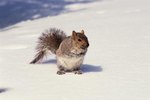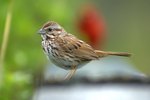
Flying squirrels like to make their homes in hollows of dead trees. Unfortunately for them, humans tend to clear out dead growth to make room for new trees. You could leave those decaying trees in place as a nice gesture for the squirrels, but all is not lost if you prefer to remove them. Make nesting boxes and install them in old coniferous stands to provide a place for the little rodents to raise a family.
Essential Overhang
Inspect your flying squirrel nesting box plans to ensure that the roof is wider than the living quarters. This is to keep your nesting box rainproof. You should have at least an eighth of an inch of overhang, but up to 3 inches will provide more of a buffer between falling rain and the entrance to the nest, as well as the seams where the wall pieces meet. You can further waterproof your flying squirrel nesting box by running a bead of silicone caulk where the boards meet and along any crack or gap.
Ventilation and Drainage
Although you want to keep rain from seeping into your squirrel nesting box, you don't want it to be airtight. The flying squirrels and their families who take up residence in your boxes will need to be able to breathe, and there should be a way for moisture to drain out of the box just in case water does find its way inside. Drill six holes, 3/8 of an inch in size, into the floor and sides of the box. Place one at each corner of the floor and one on each side toward the bottom of the box.
Entrance: Size Does Matter
Any useful plans for a flying squirrel nesting box will include instruction on placing the entrance hole as well as the size it should be. The entrance should be near the top of one of the sides or the front of the box. The size of the entrance is important because it needs to be large enough for the squirrels to come and go, but not so large that a predator could get inside. Your nesting box plans should indicate whether they're for Southern or Northern flying squirrels and should recommend an access hole size for each. For example, the entrance for a Southern flying squirrel should be precisely 1 1/4 inches while a Northern flying squirrel is a bit bigger than his southern cousin and needs a hole about 1 1/2 inches big.
Cleanliness Hinges on Accessibility
Some nesting box plans may not include a hinged door, but it's wise to build one into the side or to hinge the floor. It's not for the squirrels' convenience, but yours. You'll need a way to access the interior of the box to clean it out during the two months of the year that it will be vacant, typically January and February.
References
- Flyingsquirrels.com: Simple Nesting Box Plan for the Northern Flying Squirrel
- Sialis: Flying Squirrels in Nestboxes
- The California Spotted Owl: A Technical Assessment of Its Current Status; Jared Verner, et al, Technical Coordinators
- New Birdhouse Book: Inspiration and Instruction for Building 50 Birdhouses; Leslie Garisto
- Purdue University Extension: Size Does Matter–Nest Boxes
- NYS Wildlife Damage Mangement Unit: Best Practices
Photo Credits
-
Jupiterimages/liquidlibrary/Getty Images
Writer Bio
Elle Di Jensen has been a writer and editor since 1990. She began working in the fitness industry in 1987, and her experience includes editing and publishing a workout manual. She has an extended family of pets, including special needs animals. Jensen attended Idaho and Boise State Universities. Her work has appeared in various print and online publications.




